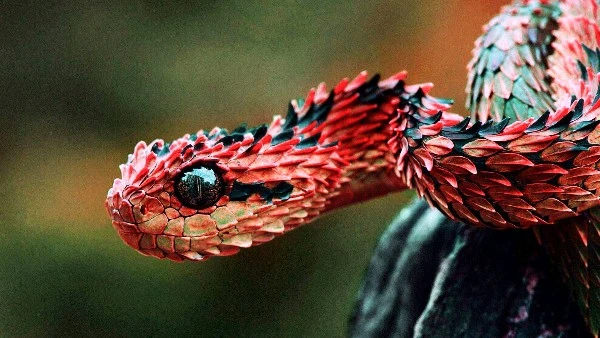Topaz tanami Woma python
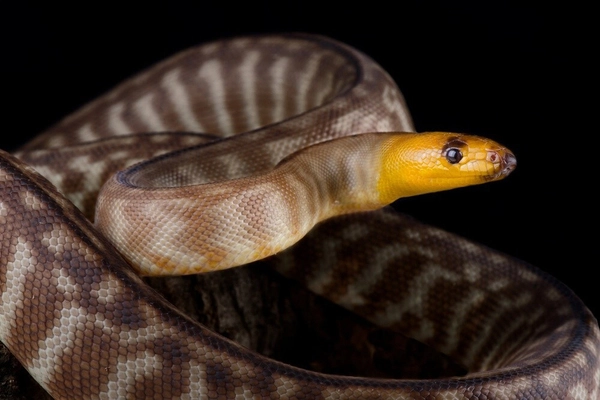
The Topaz Tanami woma python, also known as Ramsay’s python or the sand python, is an Australian python. Woma pythons have a large, flat body with smooth scales and narrow heads with small eyes. The pattern on these snakes is distinctive, consisting of a brown or olive-green base color with tints of red, pink, or orange, and dark stripes. Human encroachment robbed the woma python of much of its habitat in the 1960s, but captive-breeding operations in Australian zoos have helped rebuild native numbers. The woma python is docile and robust in captivity, making it a popular choice for individual collectors.
Scarlet Snake
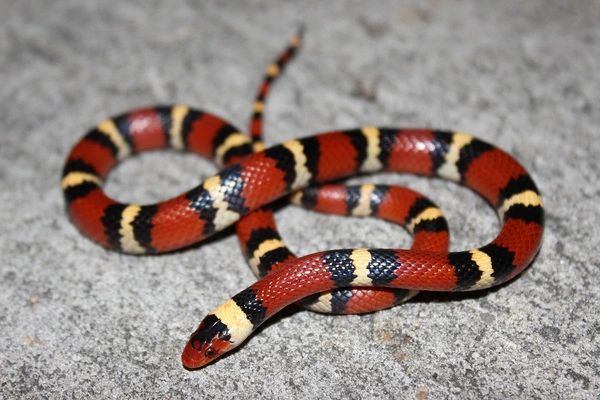
The Northern Scarlet Snake can be found in the southern and eastern United States. It burrows in open forest regions or established agricultural areas, hiding most of its time.
This nonvenomous colubrid mainly consumes reptile eggs, particularly snake eggs, but it also occasionally eats rats and lizards. It’s a little snake that can grow to be less than two feet long, with a record of 32 inches. Their entire body is covered in red, black, and yellow rings; red and yellow rings are enclosed by black rings (the red and yellow rings never touch); a red nose; the ventral pattern is the same as the dorsal pattern.
Leucistic Texas rat snake

The nonvenomous Leucistic Texas Rat Snake is mostly found in Texas. Are you also curious if this has anything to do with why it was given that name?
The term “leucistic” refers to a lack of pigmentation in all skin pigments instead of albinism, which solely affects melanin. It has a stunning white appearance due to its minimal pigmentation. It has no marks on its body and almost seems like it’s made of milk or cream. Because of their shyness, rat snakes make excellent pets while still being active. It’s always a joy to watch them.
Unlike people with albinism, animals with leucism do not have a change in eye colour. The Leucistic Texas Rat Snake, which may reach over 6 feet, has a voracious appetite for rodents, birds, frogs, and lizards.
Brazilian Rainbow Boa
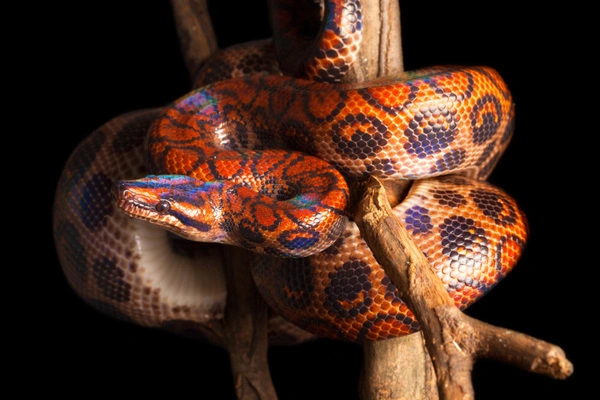
One of nature’s most gorgeous snakes in nature is the Brazilian Rainbow Boa. The iridescent appearance of its scales is due to microscopic ridges on the scales that serve as miniature prisms, refracting light. This complements the boa’s already appealing colours and elevates it to the status of a remarkable reptile. It’s a medium-sized snake with an average of 5 feet and a maximum length of 7 feet or more. The Brazilian rainbow boa is a popular captive snake species due to its attractiveness and manageable size. They take special care and don’t tolerate beginners well but thrive in the hands of intermediate to skilled keepers.
Paradise Tree Snake
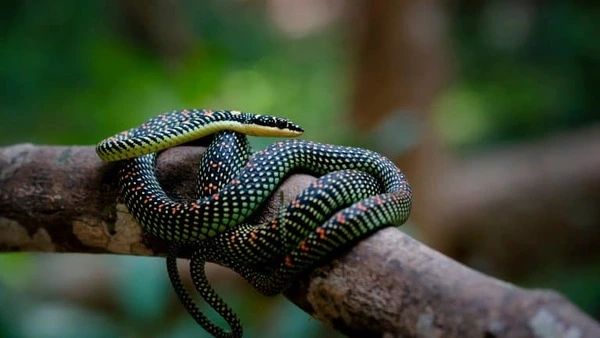
Chrysopelea paradisi, sometimes known as the paradise tree snake or paradise flying snake, is a snake species native to Southeast Asia. An ophidiophobic’s worst nightmare is a flying snake! However, don’t fret; these snakes glide rather than fly short distances from tree to tree. However, the paradise flying snake is a truly amazing sight, not just because of the unique way the species flattens its body to make it lighter and more aerodynamic, but also because of its stunning, vibrant color. There are various varieties within the Chrysopelea genus of flying snakes, but the paradise tree variant is by far the most beautiful. On the other hand, this snake is usually speckled, with alternate colors of green, orange, yellow, and red. In addition to the tiny spots, the snake’s head usually exhibits horizontal striping.
Eyelash Viper
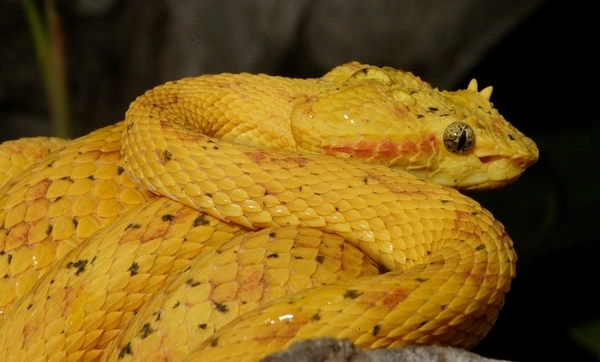
The Viperidae family contains a wide range of bright, stunning, and distinctive species, and this is the first of several gorgeous vipers on this list. The eyelash viper is one of the most well-known and attractive species. This venomous snake has to project eyelash-like scales above its huge eyes and is usually incandescent yellow.
These strange but attractive snakes are mostly found in Central and South America. They favour low-elevation, heavily shaded, thickly forested places near water as their preferred habitat. Surprisingly, researchers now believe that the viper’s “eyelashes” aid in camouflage by making the snake’s form more difficult to discern while it hides among dense plant growth.
Emerald tree boa

The Emerald Tree Boa (Corallus caninus) is a non-venomous snake found in Venezuela, Colombia, Peru, Bolivia, Guyana, Suriname, and northern Brazil.
Scientists do not recognise any subspecies at this time. Many people consider it one of the most vibrant and attractive snakes on the planet. The Emerald tree boa snake can grow around 79 inches long, or 2 meters. The tail is prehensile, the head is huge and somewhat flat, the body is laterally flattened and triangular, and the head is large and somewhat flat. Male emerald tree boas have larger spurs than females, but females are usually larger.
The dorsal skin is emerald green in hue (thus the common name), with a white triangle patch pattern that is evenly distributed.
Corn Snake

Corn Snakes (also known as Red Rat Snakes) can be found throughout the southeastern and central parts of the United States. These stunning reptiles can grow up to 6 feet long and are frequently seen in regions where small rodents congregate, as this is their principal food source. They’re calm snakes that make wonderful pets because they’re easy to care for and don’t bite much, making them a fantastic choice even for young snake aficionados.
Blue Malaysian Coral Snake
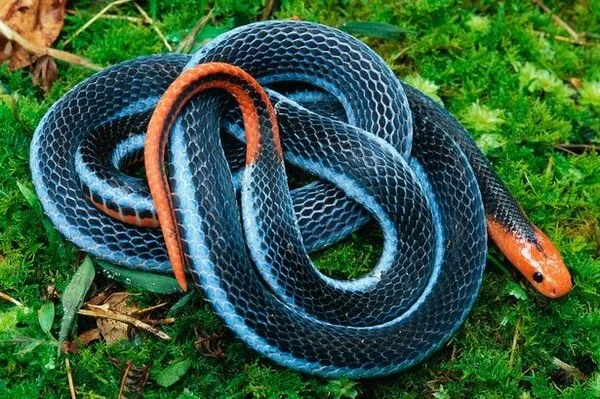
The body of this stunning snake is blue and black, with a brilliant red head and tail to match. It has a stunning appearance, but it isn’t very pleasant. And it’s both of those things at the same time! This coral snake is a Malaysian species that feeds on other snakes. It’s not a snake you’d want to own. It uses a clever defense tactic to ward off predators: it flips over and displays its bright red belly while utilising its tail as a decoy for its head. Malaysia, Thailand, Cambodia, and Singapore are all home to this snake.
Emerald Green Pit Viper

The stunning emerald green pit viper rounds out our list. As you may know, Pit vipers are among the world’s most venomous snakes. In the Himalayan mountains of Burma, emerald green vipers were first discovered in 2002. These snakes feature striking green markings on their bodies and white and red stripes and are known as the emerald viper. These lovely snakes can reach lengths of up to four feet.
This viper, like all vipers, is deadly and has fangs that are hinged. Pit vipers are legal to own in various states in the United States if you have a permit.
